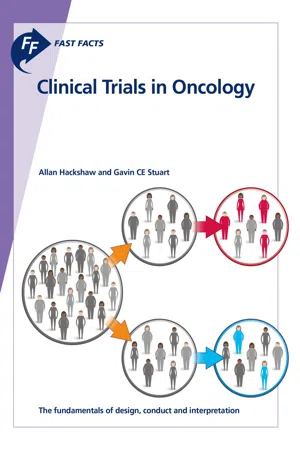
Fast Facts: Clinical Trials in Oncology
The fundamentals of design, conduct and interpretation
A. Hackshaw, G.C.E. Stuart
- 120 pages
- English
- ePUB (adapté aux mobiles)
- Disponible sur iOS et Android
Fast Facts: Clinical Trials in Oncology
The fundamentals of design, conduct and interpretation
A. Hackshaw, G.C.E. Stuart
À propos de ce livre
Written by leading experts, 'Fast Facts: Clinical Trials in Oncology' will enhance the reader's ability to critically evaluate published evidence. Assuming little or no prior knowledge, the book sets out clearly the fundamental features of clinical trials. The key attributes of Phase I–III trials of pharmaceutical products are described, as are trials of surgical procedures, radiation therapy and advanced therapies. The processes and documentation required to set up and conduct a trial are outlined, and the authors describe how trial data and real-world evidence are used to improve care. Although this concise colorful book focuses on oncology, the principles apply equally to interventions in other areas of practice. It will prove invaluable to medical, pharmaceutical and allied health professionals who want, or need, an overview of how contemporary clinical trials are designed and conducted.
Foire aux questions
| 1 | Fundamental features of clinical trials |
What is a clinical trial?

| TABLE 1.1 Key features of oncology trials | |||
Phase | Typical number of patients | Design | Primary aims |
I | <50 | Usually at least one patient cohort and open label Can be first in human | •To show adequate safety •To find a dose (drug or radiation therapy) with tolerable toxicity •To examine biological and pharmacological effects |
II | 30–100 per group | May be single arm or have several arms, including a comparator (control) | •To obtain a preliminary estimate of efficacy •To further evaluate toxicity •May inform design of Phase III trial |
III | Several hundred or thousand patients | Must be randomized and include a comparator group | •To provide definitive evidence on whether a new treatment is better than the control (superiority), similarly effective (equivalence) or not materially worse but with other advantages (non-inferiority) |
IV* | Several hundred or thousand patients | Patients from real-world practice Not usually randomized | •To monitor efficacy and safety in the population once the new treatment is used in routine practice •May identify uncommon adverse events not seen in Phase II or III trials |
| *Also referred to as postmarketing surveillance/pharmacovigilance studies. | |||
| TABLE 1.2 Key design features of clinical trials | |
Feature | Explanation |
Eligible patient population | Which patients can be recruited (inclusion and exclusion criteria) |
Interventions | Details of the new and comparator treatments, and whether randomization and blinding (placebo) are used |
Outcome measures (endpoints) | Primary: one endpoint (sometimes two or three) considered to be the most clinically relevant Secondary: supportive evidence Translational research: biomarkers in blood, tissue or urine samples, or imaging scans |
Follow-up | Type, number and timing of clinic visits and assessments, and biological specimen collection required to measure outcomes and monitor patient safety |
Sample size | Justification for the number of patients required, usually to demonstrate a statistically significant difference in the primary endpoint |